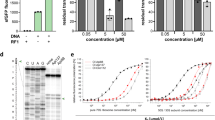Abstract
Strains of the bacterium Escherichia coli that cause infections of the human urinary tract produce so-called Pap-pili, which are hair-like appendages consisting of about 103 helically arranged subunits of the protein PapA. These pili mediate binding to digalactoside-containing glvcolipids present on the epithelial cells which line the urinary tract1,2. Recently, it has been suggested that three proteins, PapE, PapF and PapG, are responsible for this binding3,4. In the absence of PapA, non-piliated bacteria are formed which nonetheless exhibit binding, showing that the bulk of the pilus is not essential for binding3,5. Although pili can form without PapF and PapG, such pili are unable to bind to the digalactoside3. The protein PapG mediates binding specificity in trans-complementation experiments, so this protein is the digalactoside-specific adhesin6. Using immune-electron microscopy we have found that Pap-pili are heteropolymers composed of the major pilin, PapA, the minor pilins, PapE and PapF, and the adhesin, PapG. The last three proteins are located at the tip of the pilus.
This is a preview of subscription content, access via your institution
Access options
Subscribe to this journal
Receive 51 print issues and online access
$199.00 per year
only $3.90 per issue
Buy this article
- Purchase on Springer Link
- Instant access to full article PDF
Prices may be subject to local taxes which are calculated during checkout
Similar content being viewed by others
References
1. Leffler, H. & Svanborg–Eden, C. in Microbial Lectins and Agglutinins: Properties and Biological Activity (ed. Mirelman, D.) 83–111 (Wiley, New York, 1986). 2. Normark, S. et al. in Microbial Lectins and Agglutinins: Properties and Biological activity (ed. Mirelman, D.) 113–143 (Wiley, New York, 1986). 3. Lindberg, F. P., Lund, B. & Normark, S. EMBO J. 3, 1167–1173 (1984). 4. Lindberg, F., Lund, B. & Normark, S. Proc. natn. Acad. Sci. U.S.A. 83, 1891–1895 (1986). 5. Uhlin, B.–E., Norgren, M., Baga, M. & Normark, S. Proc. natn. Acad. Sci. U.S.A. 82, 1800–1804 (1985). 6. Lund, B., Lindberg, F., Marklund, B.–I. & Normark, S. Proc. natn. Acad. Sci. U.S.A. (in the press). 7. Boyer, H. W. & Roulland–Dussoix, D. J. molec. Biol. 41, 459–472 (1969). 8. Hull, R. A., Gill, R. E., Hsu, P., Minshew, B. H. & Falkow, S. Infect. Immunity 33, 933–938 (1981). 9. Baga, M., Norgren, M. & Normark, S. Cell 49, 241–251 (1987). 10. Emerson, S. V., Tokuyasu, K. & Simon, M. I. Science 169, 190–192 (1970). 11. Van Die, I., Zuidweg, E., Hoekstra, W. & Bergmans, H. Microb. Pathogen. 1, 51–56 (1986). 12. Lopez, J. & Webster, R. E. Virology 127, 177–193 (1983). 13. Grant, R. A., Lin, T.–C., Koningsberg, W. & Webster, R. E. J. biol. Chem. 256,539–546 (1981). 14. Riede, I., Drexter, K., Schwarz, H. & Henning, U. / molec. Biol. 194, 23–30 (1987). 15. Mooi, F. R., van Buuren, M., Koopman, G., Roosendaal, B. & de Graaf, F. K. J. Bact. 159,482–487(1984). 16. Mooi, F. R., Roosendaal, B., Oudega, B. & de Graaf, F. K. in Protein–Carbohydrate Interactions in Biological Systems, (ed. Lark, D. L.) 19–26 (Academic, London, 1986). 17. Maurer, L. & Orndorff, P. E. FEMS microbiol. Lett. 30, 59–66 (1985). 18. Mimion, F. C., Abraham, S. N., Beachey, E. H. & Goguen, J. D. J. Bact. 165, 1033–1036 (1986). 19. Baga, M. et al. J. Bact. 157, 330–333. 20. Frens, G. Nature 241, 20–22 (1973). 21. Norgren, M., Baga, M., Tennent, J. M. & Normark, S. Molec. Microbiol. (in the press). 22. Lowe, M. A., Holt, S. C. & Eisenstein, B. I. J. Bact. 169, 157–163 (1987).
Author information
Authors and Affiliations
Rights and permissions
About this article
Cite this article
Lindberg, F., Lund, B., Johansson, L. et al. Localization of the receptor-binding protein adhesin at the tip of the bacterial pilus. Nature 328, 84–87 (1987). https://doi.org/10.1038/328084a0
Received:
Accepted:
Issue Date:
DOI: https://doi.org/10.1038/328084a0
This article is cited by
-
Stochastic chain termination in bacterial pilus assembly
Nature Communications (2023)
-
Immunomodulation therapy offers new molecular strategies to treat UTI
Nature Reviews Urology (2022)
-
Analysis of yeh Fimbrial Gene Cluster in Escherichia coli O157:H7 in Order to Find a Genetic Marker for this Serotype
Current Microbiology (2015)
-
Impairment of the biomechanical compliance of P pili: a novel means of inhibiting uropathogenic bacterial infections?
European Biophysics Journal (2012)
-
Genetics of innate immunity and UTI susceptibility
Nature Reviews Urology (2011)
Comments
By submitting a comment you agree to abide by our Terms and Community Guidelines. If you find something abusive or that does not comply with our terms or guidelines please flag it as inappropriate.



